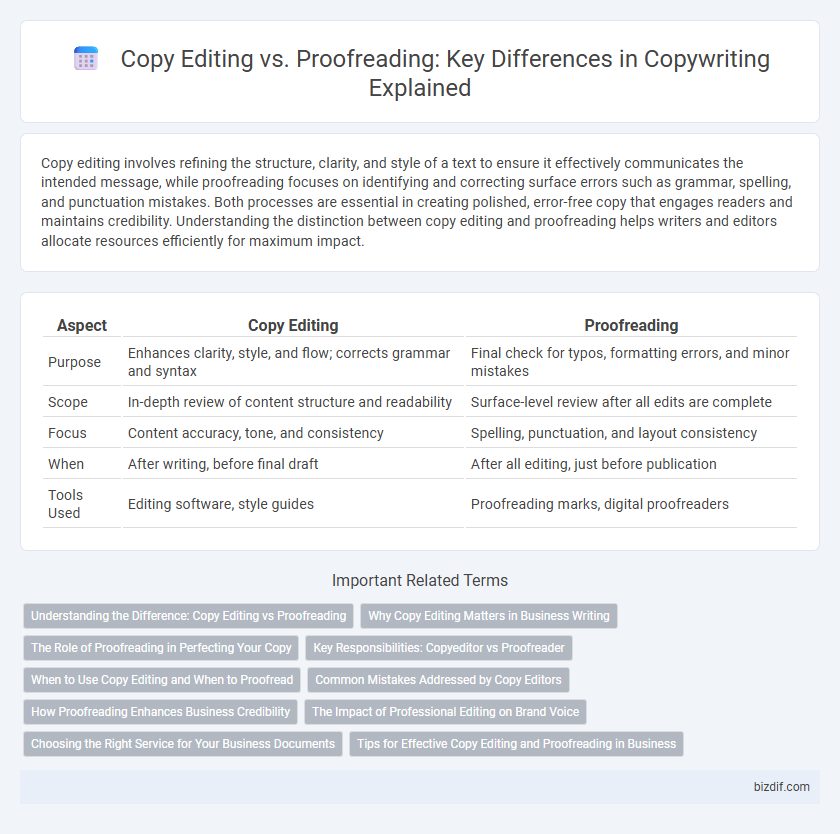Copy editing involves refining the structure, clarity, and style of a text to ensure it effectively communicates the intended message, while proofreading focuses on identifying and correcting surface errors such as grammar, spelling, and punctuation mistakes. Both processes are essential in creating polished, error-free copy that engages readers and maintains credibility. Understanding the distinction between copy editing and proofreading helps writers and editors allocate resources efficiently for maximum impact.
Table of Comparison
| Aspect | Copy Editing | Proofreading |
|---|---|---|
| Purpose | Enhances clarity, style, and flow; corrects grammar and syntax | Final check for typos, formatting errors, and minor mistakes |
| Scope | In-depth review of content structure and readability | Surface-level review after all edits are complete |
| Focus | Content accuracy, tone, and consistency | Spelling, punctuation, and layout consistency |
| When | After writing, before final draft | After all editing, just before publication |
| Tools Used | Editing software, style guides | Proofreading marks, digital proofreaders |
Understanding the Difference: Copy Editing vs Proofreading
Copy editing focuses on improving clarity, consistency, and style by addressing grammar, punctuation, and sentence structure, while proofreading is the final check for typographical errors and formatting issues before publication. Copy editors ensure content flows logically and adheres to brand voice, whereas proofreaders focus exclusively on identifying overlooked mistakes. Understanding the difference between copy editing and proofreading enhances the overall quality and professionalism of written content.
Why Copy Editing Matters in Business Writing
Copy editing enhances business writing by ensuring clarity, consistency, and professionalism, which directly impacts brand credibility and customer trust. It goes beyond proofreading by refining tone, style, and message accuracy, making content more persuasive and aligned with business goals. Effective copy editing reduces errors and misunderstandings, resulting in stronger communication and improved client relationships.
The Role of Proofreading in Perfecting Your Copy
Proofreading plays a crucial role in perfecting your copy by meticulously identifying and correcting spelling, grammar, punctuation, and formatting errors overlooked during earlier stages. Unlike copy editing, which improves clarity, style, and flow, proofreading ensures the final text is error-free and polished for publication. This step guarantees professional quality, enhances readability, and preserves brand credibility.
Key Responsibilities: Copyeditor vs Proofreader
Copy editors focus on improving the clarity, coherence, and overall flow of content by correcting grammar, punctuation, style, and factual inconsistencies, while ensuring adherence to style guides. Proofreaders primarily perform the final review to identify and correct typographical errors, spelling mistakes, and formatting issues before publication. Both roles are essential for producing polished, error-free written materials that meet professional standards.
When to Use Copy Editing and When to Proofread
Copy editing is essential during the drafting phase to refine clarity, style, and consistency, ensuring the content aligns with brand voice and intended message. Proofreading is best suited for the final stage of content production, focusing on catching typographical errors, grammar mistakes, and formatting issues. Use copy editing when the text requires structural improvements, and proofread to polish and verify error-free presentation before publication.
Common Mistakes Addressed by Copy Editors
Copy editors correct common mistakes such as grammatical errors, awkward phrasing, and inconsistent tone to improve clarity and flow. They also ensure proper punctuation and adherence to style guides, while fixing factual inaccuracies and enhancing overall readability. By addressing these issues, copy editors elevate the text beyond mere surface-level corrections handled in proofreading.
How Proofreading Enhances Business Credibility
Proofreading enhances business credibility by ensuring all written materials are free from spelling, grammar, and punctuation errors that could undermine professionalism. Meticulous proofreading reinforces brand trust by delivering polished content that resonates with target audiences. Consistent error-free communication fosters confidence in products and services, directly impacting customer acquisition and retention.
The Impact of Professional Editing on Brand Voice
Professional editing sharpens brand voice by ensuring clarity, consistency, and tone alignment across all content, enhancing audience engagement and trust. Copy editing refines grammar, structure, and style, solidifying the brand's personality, while proofreading eliminates errors that could undermine credibility. Together, these processes elevate the overall quality of messaging, reinforcing brand identity and differentiating it in competitive markets.
Choosing the Right Service for Your Business Documents
Copy editing enhances clarity, consistency, and tone by refining grammar, style, and structure, ensuring your business documents communicate effectively. Proofreading focuses on catching surface errors like typos, punctuation mistakes, and formatting issues before final publication. Selecting between copy editing and proofreading depends on your document's stage and the level of polish required to present a professional image.
Tips for Effective Copy Editing and Proofreading in Business
Effective copy editing in business requires a thorough review of content for clarity, consistency, and tone to ensure the message aligns with brand identity and engages the target audience. Proofreading focuses on correcting grammatical errors, punctuation, and spelling mistakes to maintain professionalism and credibility. Utilizing checklists, reading aloud, and employing digital tools like Grammarly or Hemingway Editor enhance accuracy and streamline the editing and proofreading process.
Copy Editing vs Proofreading Infographic

 bizdif.com
bizdif.com